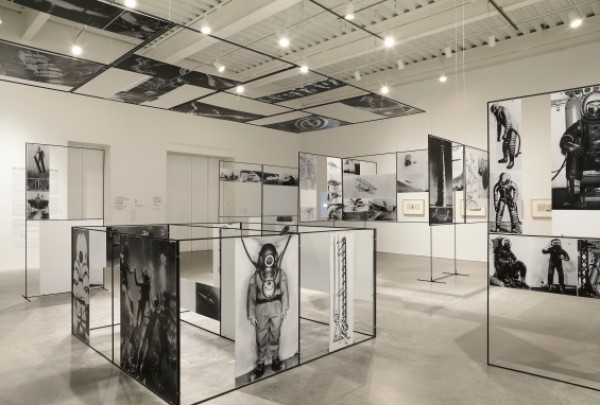
Richard Hamilton, “Man, Machine and Motion,” exhibition reconstruction, 1955/2012 (photo by Benoit Pailley)
New Museum of Contemporary Art
235 Bowery at Prince St.
Friday – Sunday through September 30, $12-$16
212-219-1222
www.newmuseum.org
“From a contemporary perspective, the distance between our machines and our selves has never been closer,” writes Gary Carrion-Murayari in “The Body Is a Machine,” one of several marvelous essays in the catalog of the fascinating New Museum show “Ghosts in the Machine,” which runs through this Sunday. Curated by Carrion-Murayari and Massimiliano Gioni, the exhibit examines the intersection between man, motion, art, and machine in a consumer society growing more and more obsessed with pop culture. Spread across four floors, “Ghosts in the Machine” features painting, sculpture, film, and installations focused on a time before the personal computer, when a developing technology was not as all-pervasive as it is today. In Stan VanDerBeek’s 1960s “Movie-Drome,” visitors can lie down inside a dome and watch myriad images projected onto the curved ceiling, an early version of the internet. A reconstruction of Richard Hamilton’s seminal 1955 “Man, Machine and Motion” follows humanity’s pursuit of going faster, farther, and higher, even foreseeing space travel. “The Medium Is the Medium” is a 1969 public television program in which Allan Kaprow, Nam June Paik, Otto Piene, and Aldo Tambellini create short films using cutting-edge technology. Paul Sharits makes the film projector itself the key element in “Epileptic Seizure Comparison.” Harley Cokeliss’s “Crash!” video, Claus Oldenburg’s “Profile Airflow,” and Thomas Bayrle’s “Madonna Mercedes” examine the world’s growing love affair with the automobile. Works by Channa Horwitz, Bridget Riley, Victor Vasarely, and Emma Kunz play with perception in mathematical, scientific, and architectural patterns. Otto Piene’s “Hängende Lichtkugel” and Gianni Colombo’s “Spazio Elastico” use light to alter reality. Hans Haacke creates a bit of magic in “Sphere in Oblique Air Jet” and “Blue Sail.” Among the more contemporary pieces, Henrik Olesen pays homage to Man Ray, Marcel Duchamp, Alan Turing, and outdated machines in such works as “Apple (Ghost) (1),” an old apple computer wrapped in plastic, and “Imitation/Enigma (2),” a sewing machine tied up in a blanket, while Seth Price repurposes licensed images in “Film/Right” and Philippe Parreno investigates an automaton in the miniature “The Writer.” Other artists represented in the show are J. G. Ballard, Eduardo Paolozzi, Rube Goldberg, Robert Smithson, Konrad Klapcheck, and Herb Schneider. In today’s crazy, fast-paced, constantly connected world, “Ghosts in the Machine” offers an intriguing, involving look back at a different era, one that, knowingly or not, paved the way for today’s consumer-driven digital age. (Also this weekend at the New Museum, the “Propositions” series continues with writer and curator Fionn Meade presenting “When Genealogy Becomes Critique,” a two-day seminar [Friday at 7:00 and Saturday at 3:00, $8 plus half-gallery same-day admission] dealing with art criticism, cinefication, and historiography.)